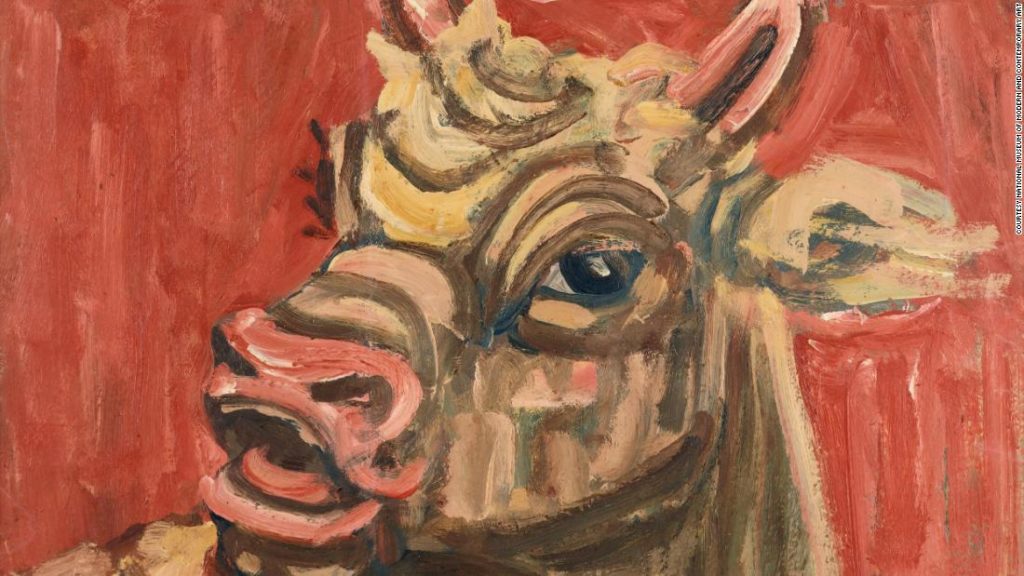Museum visitors have been given a first look at some of the 23,000 artworks donated to South Korea from the collection of Samsung’s late chairman, Lee Kun-hee.
Two exhibitions of the items opened in Seoul on Wednesday, just months after the businessman’s family announced the donation as it seeks to settle an inheritance tax bill of over 12 trillion won ($10.4 billion).
The works are showing at the National Museum of Korea and National Museum of Modern and Contemporary Art (MMCA), the recipients of Lee’s vast collection. Items on display include centuries-old antiques and contemporary Korean artworks, while paintings by Western names like Pablo Picasso and Claude Monet are set to be unveiled next year.

“Clearing after Rain on Mount Inwang,” created by court painter Jeong Seon in 1751. Credit: Courtesy National Museum of Korea
That same day, South Korea’s Ministry of Culture, Sports and Tourism revealed that the Lee family was donating approximately 23,000 antiques and artworks to public collections. In a press statement at the time, the ministry said the acquisition would help the two institutions “compete with famous museums abroad.”
Neither Lee’s relatives nor the museums have disclosed the value of the donation or confirmed how, or even whether, it will figure into the family’s inheritance tax commitments.

A painting by Pierre-Auguste Renoir, “La Lecture,” was among the items donated by Lee’s family to the National Museum of Modern and Contemporary Art (MMCA). Credit: Courtesy National Museum of Modern and Contemporary Art
MMCA received almost 1,500 of the works, in what the museum this week called “the donation of the century.” According to senior curator Park Mihwa, the collection of paintings, drawings and sculptures represented the single largest contribution received by the museum “in terms of both value and scale.”
“The rare and major artworks of the early 20th century and overseas works have greatly enhanced the quality and quantity of the museum,” Park told CNN, describing the acquisition as “an opportunity to expand the horizons of art history research through continuous research.”
“We have obtained masterpieces that would have been difficult to purchase with our annual collection budget of 5 billion won ($4.35 million),” she added. “So we expect this collection will help art tourism as well as help South Korea to become a powerhouse of art culture in the future.”
Artists ‘loved by Koreans’
Among the items acquired by MMCA are 119 works by Western artists, including Paul Gauguin, Pierre-Auguste Renoir, Camille Pissarro, Marc Chagall, Salvador Dalí and Joan Miró. But more than 90% of the pieces are by contemporary Korean artists, including over 100 works by painter Lee Jungseop and almost 70 by celebrated craftsman Yoo Kangyul.

“Women and Jars,” by Korean painter Kim Whanki. Credit: Courtesy National Museum of Modern and Contemporary Art
The museum’s new exhibition features art created from the 1920s to 1970s, spanning the periods of Japanese occupation, the Korean War and the subsequent military dictatorship. Park said the show highlights work “by 34 artists loved by Koreans,” including influential landscape artist Byeon Gwansik, abstract painter Kim Whanki and contemporary sculptor Kwon Jinkyu.
At the National Museum of Korea, meanwhile, an exhibition of older artifacts from Lee’s collection also opened Wednesday. The show features 45 historical items, including Buddhist statues, rare woodblock prints and Bronze Age earthenware.
The museum is also exhibiting a number of items deemed “National Treasures” by the South Korean government, including an ink wash painting by the Joseon dynasty court artist Jeong Seon and a gilt bronze bodhisattva dating back to the 6th century.

A bodhisattva, cast in bronze in the 6th century, was among the items deemed a “National Treasure” by South Korea’s government. Credit: Courtesy National Museum of Korea
Top image: “Bull,” (c. 1950s) by Korean painter Lee Jungseop.
You may also like
-
Afghanistan: Civilian casualties hit record high amid US withdrawal, UN says
-
How Taiwan is trying to defend against a cyber ‘World War III’
-
Pandemic travel news this week: Quarantine escapes and airplane disguises
-
Why would anyone trust Brexit Britain again?
-
Black fungus: A second crisis is killing survivors of India’s worst Covid wave

